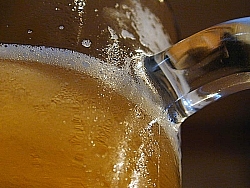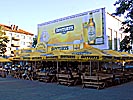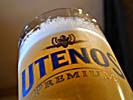How is the Lithuanian economy? Very well, thank you. Rising like a rocket. Is there any food fit for us westerners?
Hey man! Lithuania is a western country. You will find most dishes that you are used to, although differently styled.
Shopping for food like the locals can be an adventure. The market places are much more interesting and content-rich
than you are used to. The middle class Lithuanian leads a very good life. A travelogue I once read, dealt with
a trip through Russia, Belarus and Ukraine, and the writer finished off by observing: “Ah, Vilnius. Back in civilisation!”
But let us not forget those who do not ride high on the new economy. But they know how to cook. Some Lithuanian
recipes are available here (in Swedish and Lithuanian only).
The Food, the Restaurants and the Prices
|
| Lithuania is still very cheap for westerners (2005). If you avoid the absolute population
centres and eat in the countryside, like in Ignalina for example, you can easily have double main courses, and
soup, and a lot of beer and lots of snacks with it, for the same prices as for two ice creams in downtown Vilnius.
After you have seen enough of Vilnius, get out in the country. |
|
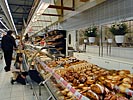
|
Lithuania is mainly a country of breads. The amount and varieties surprises us Swedes, mostly used to one type
only, non-tasting white bread. There is light bread, half-light, medium brown, brown, medium black and black, in
lots of tastes. |
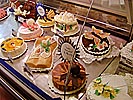
|
The cake counters are pure art. Again, Swedes are poor with only marzipan and strawberry cakes. Here are armies
of red, green and yellow cakes, round or figure-shaped. |
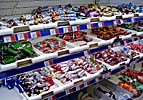
|
Surelis is chocolate-covered cottage cheese, healthy goodies that Lithuanian kids down in large volumes.
You can have them with strawberries, cherries, lemon, poppy seeds, anything |
|
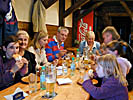
|
Get out in the country and get better food than in the cities. Like here in Ignalina, where food is only one tenth
of the big-city price. |
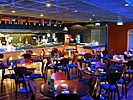
|
The bar and restaurant life is much like everywhere else. |
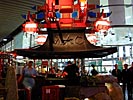
|
And you can eat Chinese, Japanese, Indian, Indonesian, French and everything else you don’t need, when there
is Lithuanian food! |
|
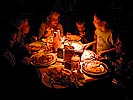
|
So where do city-dwellers go? Pizza has become very popular. The are so many add-ons on the tables you can hardly
fit the food. |
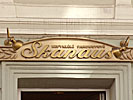
|
The Lithuanians are café-goers of Viennese calibre. Skanaus Café (“Bon
appetit”) in the Old Town. |
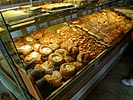
|
The cafés are very well stocked. Much of the filling is varske, various kinds of cottage cheese. |
|

|
An elegant party at home
”Champagne should be cold, dry and preferably free” Sir Winston Churchill once said and I wish I could agree with
this great statesman, but I cannot understand why one should force a bitter fluid down the throat, showing a forced
smile, when there is sweet, Muscat-based Alita? Champagne should be cold, dry and preferably Lithuanian.
|
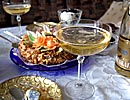
|
| The Lithuanians are smart and they take after the surrounding world. If you had thought
of eating only in Vilnius’ Old Town, or at Trakai Castle, or live in the city centre hotels, then you will have
to pay through the nose. And there is no shortage of hotels. Novotel, Radisson, Holiday Inn and others are very
good at keeping the prices up. The price for a rental car almost makes your heart stop. Western cars, that is.
But try a small, local company with not so new shiny models, and the prices are lower. It’s OK to travel in an
older car, too. |
Turgus and Gariunai, European Bazaars
|
Lovely smells, big tomatoes, knotty cucumbers, all-natural strawberries in uneven, non-fantastic
sizes and colours, wild strawberries, camomile, real cherries, eggs without any form of stamp on them, and unmarked
butter. Here, people buy loose herbs and cucumbers whose straightness does not follow EU’s strict regulations,
and the merchants haggle about prices. This might sound like we are in some exotic Arab country, but it happens
to be turgus, one of many market places
in Vilnius.
There we are, stupid Swedish, with our terrible, un-tasting ”tomatoes-on-a-twig,” cheering at the high quality.
I reality we are duped in our super-hygenic supermarkets with green spotlights in the grocery department to make
everything look better. In Lithuania
things are really better! |
|

|
Ordinary people buy their food on turgus, and get home with products that taste better than what we can get in
Coop Sweden, and to far lower prices. |
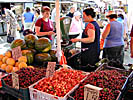
|
You smell dill and parsley, someone fries bread with garlic, and the smoked chicken is seducing. The tomatoes are
3 litas a kilo, the potatoes 1.50. |

|
And it’s not “potatoes,” but seven different types from all the regions of the country. The farmers trade themselves,
and the farmers’ wives remove the bad ones for you. Here are big sacks of peeled walnut, Brazil-nuts, cashew and
the like, the we are only able to buy in little 50 gram bags to frightening prices, in Sweden. In Lithuania the
farmers are tired of giant co-operative organisations, middlemen and someone else taking the profit. |
|
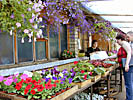
|
And there is no shortage of flowers. Right beside are the herb salespeople. |
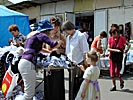
|
The clothes market is fantastic, with prices we cannot understand. And yet it is the Lithuanian knitwear factories
that supply the Swedish fashion chains. By then the prices have gone up ten times. But clothes are no fun, so I
didn’t make any pictures there. |
|
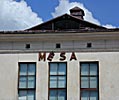
|
We had open meat markets in Sweden before, but not any longer. Here the pork lies in rows on a stone counter around
the room and all small slaughters have their own refrigerated counters. |
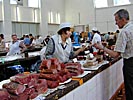
|
Know-all Swedes may have doubts about hygiene, but things have been working this way as far back as anyone cares
to remember. So it can’t be all that dangerous. |
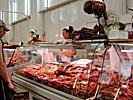
|
They have a lot of interesting, smoked products we haven’t even seen in Sweden. Smoked chicken, spiral sausage,
dark, lovely beer sausages. The house is 300 metres of meat. The smoked meat is tied with string in a haphazard
fashion - hand made. And everywhere they let you taste the ham and sausages. Just show some interest and the assistant
is fast to cut some for you. Thin slices of dark, salted, spiced, smoked fillet of beef, heavenly. Who’d let you
taste that in Coop Sweden? |
|

|
The little dog sitting in the main aisle was probably in heaven. “Did you buy a sausage for it,” a friend asked. |
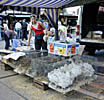
|
Turgus has always been the farmers’ market and chicken, hens and puppies are still sold in the middle of town. |
|

|
Little yellow chirping chicks, ducks and crowing roosters. |
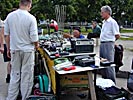
|
Outside the fence is the grey zone of tools and electro-things. You look at the car stereos... |

|
...with oddly snipped-off cables, old electricity meters, spanner kits, drill bits, grinding wheels and milling
tools, and wonder how much of it is actually legal. |
| It’s a strange mix. Among the water taps you suddenly find a 10 GHz 20-element yagi antenna for satellite television,
a budget alternative to a parabolic. Close by, other water-tap-salesmen are selling other types of TV antennas.
It seems like part of the plumbing business, selling TV antennas. |
Fear is the Key
|
|
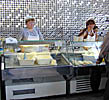
|
They warn you of taking pictures on turgus. People are still scared despite Communism disappeared long ago. Touring
the chicken and cheese house, the old distrust comes out anew. |

|
If you’re going to photograph on turgus, learn a Russian phrase: “Look out, he’s got a camera!” Another good, frequently
used word is “durak”, stupid. Had I stayed any longer in the cheese house, I had been chased out. |
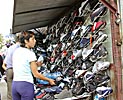
|
I little, crooked old lady sitting, selling dill wanted money to be photographed. All right, some need to take
extra care. Selling pirate CD’s... |
|
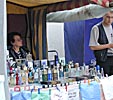
|
...fake perfume and “brand name” shoes hasn’t decreased at all. You can get some real good games and software real
cheap, without fattening the already too fat game producers. |
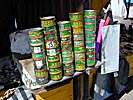
|
“Ikra” (NKPA), caviar, especially sturgeon, that has been standing in the sun for a few hours, how good is that?
And who caught it? How many sturgeons are left? |
If you accompany a Lithuanian on turgus, do them a favour and stay a few metres behind,
so they can shop to proper prices. If you stand right behind, tourist with your gleaming camera, the prices double
in a hurry. |
|
A Russian drunken brawl is another thing you just gotta see, as it rolls along the street. You
get to learn a lot of good words.
|
Gariunai
|
| 20 minutes outside Vilnius is a market place big as an airport, with tens of thousands of cars packed side by side,
and the electricity work’s cooling towers behind. It has ample room for 100,000 people and it sprang up outside
the Communist economy. The Lithuanians call it “The largest market in Europe”, and considering its size, it may
actually be true. People come there from all the Baltic States, from Poland, Russia, Byelorussia, Western Europe,
Asia, all the way from Vietnam and the Arab world to sell and buy things. In all eastern European languages. |
|
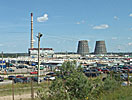
|
You can find anything from cheap detergent, children's clothes, car spares, stolen car stereos
with the characteristically snipped-off cables, knickknacks, to software and all-new ex-Red Army night-vision telescopes,
everything!
|
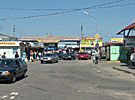
|
|
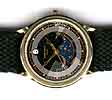
|
And wristwatches. In 1996 I bought a Russian POLJOT with POM indicator and all, but that was a mistake. The first
day the winding screw fell out, a few months later the date-ring started lagging, showing only half days, and one
morning I discovered cracks in the glass. “Strange,” I thought, tapped it and bang, had my bed full of broken
glass. It was the same with everything made in the Soviet Union. If it wasn’t broken when it left the factory,
it would break a few months later. |
Roadside Restaurants and Dining Palaces
|
| Roadside restaurants are quite popular in Lithuania, and I’m not talking about plastic places
like those along the Swedish highways, serving pop music and sour coffee, I’m talking about Dining Palaces! |
|
Berneliu Uzeiga (The Boys’ Inn)
On the road between Vilnius and Kaunas you’ll find The Boys’ Inn
, Berneliu Uzeiga.
|
|
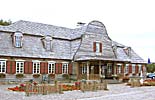
|
To say it’s popular would be wrong. People stand in line to eat plain food in a rustic setting. |
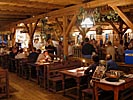
|
Inside it’s very rustic, with naked rafters and a lot of old farming tools on the walls. The have dancing in the
evening. |
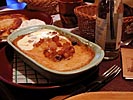
|
Food is served as rustically as possible. This is kugelis, a baked potato dish
with chicken legs and sour cream on top. |
|
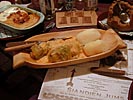
|
This is stuffed cabbage rolls, just like we do at home, served with potatoes
on a rustic wooden plate. |

|
One very special dish is soup inside bread. You can see the expectant, hungry
people lifting the lids off the soup of the day. |
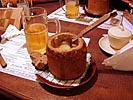
|
The same soup, close-up. They bake their own black bread with cumin, cut out the centre, pour in the soup and put
the lid back on. You spoon up the soup and then chew the bread. You can take the “bowl” along to munch during the
rest of the drive. |
|
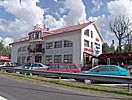
|
Deivina, another place on the road between Vilnius and Kaunas. |
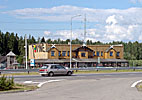
|
Across the road lies Tevyne (the fatherland). The Vilnius-Kaunas road is a popular commuting trek. All large food
joints has something rustic for the kids to play around in. |
|
Pas Juozapa (Joseph’s Place)
The summit of all Lithuanian dining palaces can be found by the coast, 4 kilometres
from Palanga in the Zemaitija district. It doesn’t matter that the place has more than 1000 seats. It’s always
full. That says something about the quality.
|
|
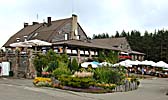
|
Pas Juozapa started out as a small family restaurant, but the business idea hit bull’s-eye and it soon grew
to a whole amusement park, popular like none else. |
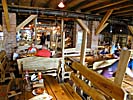
|
Again we see Lithuanian plain food, this time from the Zemaitia (the lowlands), i.e. ordinary farmer’s food in
rustic, impact resistant country environment... |
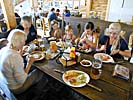
|
...where people will line up for hours to get in, despite it’s in the middle of nowhere. Everyone tucks in, except
the poor photographer, who must to stand and look, as the food grows cold. |
|

|
Below is a cutaway view of the Zemaitian food. You always start off with a few large beers. The
only beer available is Juozapas own “Jouzo HBH”, dark or light, filtered or unfiltered, and it tastes really great.
There is no advertising in the restaurant, and no Svutyrus tents either. It feels quite unusual. With the beer
comes the snacks. The Lithuanians are masters of beer snacks. While the rest of the world chews peanuts with their
beer...
|
|
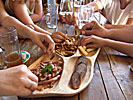
|
...the Lithuanians order big plates of fried bread with garlic, cheeses, smoked eel,
smoked shredded pig’s ears (yes!) and soft-boiled yellow peas with bacon. |
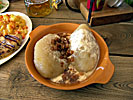
|
Cepelinai, potato dumplings filled with mashed meat or cottage cheese. Probably
the most beloved Lithuanian dish of all. |
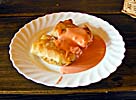
|
Blyneliai, (little) crepes with mashed potato filling. |
|
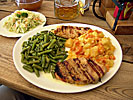
|
Tender woman, sumptuous, grilled filet of chicken with carrots and potatoes
in white sauce. |
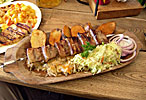
|
Skewered spare ribs with grilled potatoes and sauerkraut is not bad. |
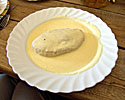
|
Zemaitiu blynai, zemaitijan potato-filled crepes. Zemaitija is a potato
district. |
|
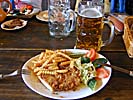
|
Lithuanian karbonadas, a large slice of pork coated with egg and breadcrumbs,
somewhat like a pork schnitzel. But the fries are un-Lithaunian. |
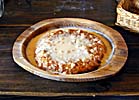
|
Studentiskas, student food, i.e. lots and very cheap, potato mix and mashed
meat baked in the oven. |
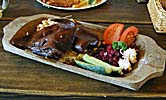
|
And the Clou: Whole smoked pig’s ears with pickled gherkin and diced beetroot.
Yum-yum! |
|
 
|
No Lithuanian meeting-place without wooden sculptures. A mean Mongolian warrior and a woman bringing beer. Very
fitting. |
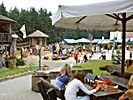
|
There is an amusement park where the kids can ride horses and scream their heads off before dinner. If you want,
you can wash your car and buy souvenirs, too. |
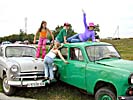
|
Veteran car collection: Finest Russian quality cars. Old memories, hopefully gone forever. Trabant, Vaz, Volga.
The kids can jump around without damaging anything. |
Jouzas’ prices are fantastic, perhaps some 10% of the Swedish, despite top notch quality and fast service. There’s
something wrong with Sweden.
The idyllic atmosphere fades somehow as the staff pumps up the volume. That cursed rock music you can’t seem to
escape anywhere. 2005 still saw the same great food and the same great prices, but the music has become so obtrusive
that it is now unpleasant to eat in those spots where you can’t avoid it. If it continues like this Juozas risks
getting a McDonald's image that cold be difficult to get rid of. The playground, which rang of children’s laughter,
now has a loudspeaker in each corner, pumping out blaring rock music so you can barely hear the kids. Except for
the days when there are live concerts. Then, it’s unbearable. There are also televisions mounted in the roof everywhere,
making the kids watch TV instead of eating the food. And that’s real bad, considering the high quallity.
Juozapas was offered millions to start a similar eating place near Moscow, but he declined. Perhaps he didn’t want
to feed the Russian Mafia unnecessarily. |
The New Lithuania
|
Something fantastic has happened in Lithuania during the last five years (1999-2004). Around
Vilnius, supermarkets has sprouted that we well-off Swedes could only dream of, with bowling alleys, ice-skating
rinks and lots of cinemas, apart from the restaurants, electronics shops and food halls. And it’s not only one,
but many, in this little itty-bitty 300,000 inhabitants town. Three ice palaces. Open around the clock. And it’s
full up! If they weren’t, these places would soon go bankrupt.
The new Lithuanian capital just sits waiting out in the boring, macroscopic Soviet-built suburbs. The old Vaz and
Ladas will soon be history. Now the streets are full of Volvos and Japanese minicars. And we’re not talking about
the hyper-rich driving around town in those absurdly long, white limos. There just aren’t that many managers and Mafia bosses with unlimited economic means. |
|

|
Typical macroscopic Soviet-built suburb with typical capital waiting. |
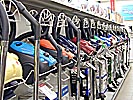
|
There are many giant centres meant for amusement and purchasing, but let’s take Akropolis as an example, sporting
ten thousands of square metres of spending surface. |
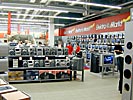
|
The electronics departments usually indicate the country’s income level. No problems here, it seems. |
|
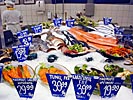
|
We have all seen salmon and cod before, but there are a few fishes we’ve never tried, like carp and sturgeon, fresh
from a fish-tank. |
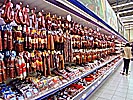
|
The sausage industry is booming, it seems. This is what happens when each little village has its own factory, and
not one big co-operative force ruling everything. |
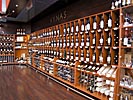
|
Less dilly-dally with alcohol than in Sweden brings wine departments like this. Well-kept and well-stocked. |
|
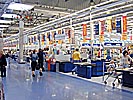
|
Food items are found in giant food hall chains, such as Maxima. The row of check-outs shows the size, some 46 in
all. |
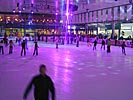
|
It’s mostly horribly Americanised shopping-corridors with fashion, fashion and fashion, but then a glint of true
Lithuania shows through in the decor. |
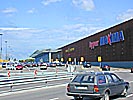
|
And everywhere it’s hyper-clean. Some difference to the old times. Now, after the gloom has released its grip on
the ordinary Lithuanian, and he has crawled out of the Soviet mud, he can return to his earlier habits of being
a cultivated human. |
|
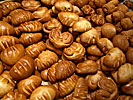
|
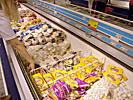
|
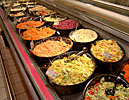
|
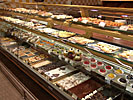
|
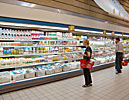
|
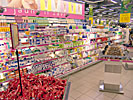
|
Seeing the Lithuanian diversity in a supermarket in 2005 makes me feel sincerely sad for the Swedish food marketplace,
and for the shopping Swedes, thinking that we are on top of the world. Let’s take a detail like the buns, for example.
In-shop bakeries is nothing new, but what have we here? Buns with some 46 different fillings, like apricot, cherry,
blueberry, mashed meat, pear, apple, cottage cheese, chocolate, orange, strawberry, wild strawberry, poppy seeds,
sausage, vanilla or mixtures thereof. There are lots of koldunai (potato dumplings), Lithuanian national
food, in the freezers. The salad counters are overflowing. The cake counters are like rainbows. They have no near-monopoly
on dairy items like in Sweden. They have 25 kinds of milk. Each city with self-esteem has its own dairy. Milk in
five-litre bottles is a fantastic idea that hasn’t reached Sweden yet.
Any Western woman would be at ease in the well-stuffed makeup departments. Middle-European dessert cheeses have
finally made their way into Lithuania. Earlier they had only traditional cottage cheese, but now the counters overflow
with Brie, Camembert, green, black, blue and all other kinds of moulds you can think of. And the Lithuanians have
started making their own French-style dessert cheeses.
The book shop is well-stocked, and I am impressed by the adorned, translated luxury issues of, for example, Egyptology
for kids, costing only 50 litas. They would cost upwards of 400 crowns in Sweden. Looking into a furniture outlet
I feel that IKEA will have problems establishing in Vilnius.
But let us not forget the downsides: |
|
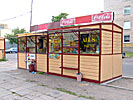
|
The Kiosk Economy
The Baltic countries had a flourishing kiosk economy. In all suburbs, right where they were needed most, there
were long lines of rusty kiosks. From their dark innards you could buy most necessities, such as bread, milk, vegetables,
soda, beer, bus tickets, newspapers, etc., but they were more or less gone in 2005. The competition from supermarkets
and the fact that most people now own cars, has erased this form of distributed micro-shops. They were very useful
when you ran out of beer on a Saturday evening. In 2004, 165 of them were closed in Vilnius alone, due to economic
irregularities. |
|
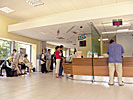
|
The banks are wiser
The Lithuanian banks have risen from absolute wretchedness to nice shiny offices with marble floors. They have
learnt a lot from Swedish banks. You can now wait in line for an eternity because the physical customers are to
be “phased out” in favour of Internet banks and ATM:s. The fees are increasing. The bank offices are filled with
people waiting in line, and behind the desks elegantly dressed girls rush to and fro, doing, seemingly, nothing.
Welcome aboard! You better change your currency in a currency exchange. |
Ancient Cult Place?
|
| An ancient cult place? Almost. A Soviet failure: a half-finished sports stadium. A dinosaur
of bad concrete, slowly being devoured by nature. |
|
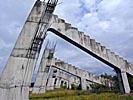
|
The Soviets were building it as the Soviet Union was crumbling. No one has continued building it. |

|
Instead, it crouches, crippled by the new symbol of capitalism, the Supermarket. This may look like a lot of images
of large concrete chunks... |

|
but I am just so amazed by the whole thing, that they started building something so grand, and then just disappeared. |
|
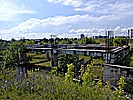
|
It is kind of like the Toltecs or some other strange, ancient culture, which built grand structures and then just
disappeared without leaving any other traces. |
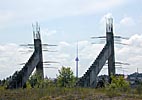
|
I want this last image to show the old and the new together, a stadium built by a fleeing people, while the TV
tower, that saw hideous scenes of massacre, remains like a monument to the success of the new Lithuania. |
And the Lithuanians don’t give up easy. The stadium was meant to be a giant, the biggest in the Soviet Union. Now,
there are plans to actually continue building, and make a modern stadium out of it. Or just topple what’s left
and build a better one. Many emigrated Lithuanians that have become sports stars in the U.S., mostly in basketball,
return to their home country and invest big in schools and sports centres. |
|
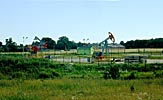
|
Oil pumps whirr along the coast. They don’t make much, but enough to be noted by the CIA World Factbook. |
But the new, shining prosperity isn’t for all. The pensioners still suffer from a wrecked pension system, even
if the system actually demonstrated some profit in 2004. Neither are the students very prosperous. And, as usual
there is a division between town and country. |
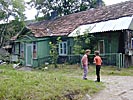
|
A poor neighbourhood in Vilnius, whose citizens are despised. But that is unfair, because the poor people living
there cannot roll themselves in luxury like the new rich. |
| Now, let us not deny the Lithuanians the good things that they have fought so hard for.
Had Sweden developed with the same pace, instead of reversing, we might have been able to re-take our title as
the world’s richest country. Now we are at 11:th place, and the trend is not what one would call “hausse”. |
